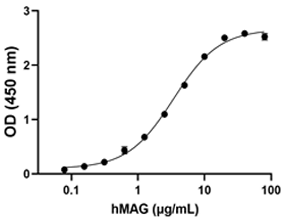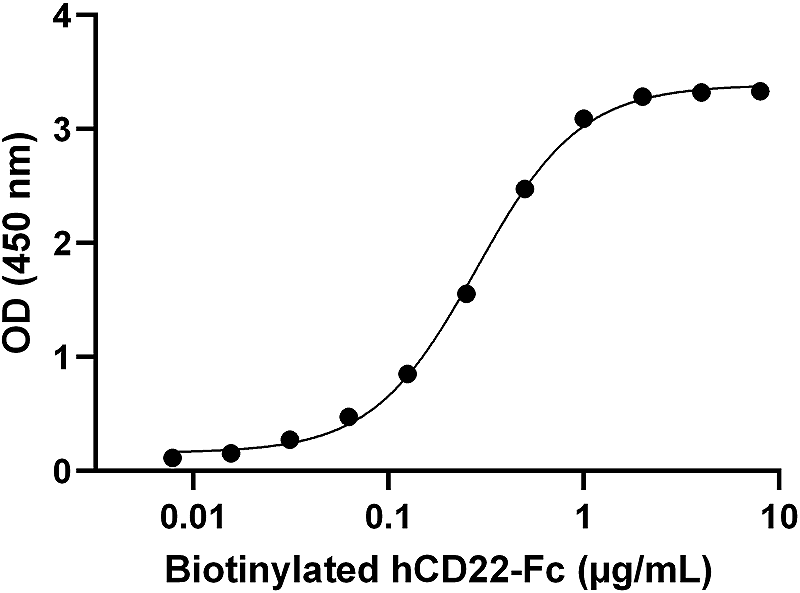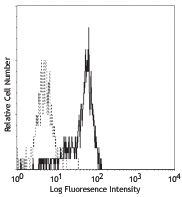- Regulatory Status
- RUO
- Other Names
- CD170, OBBP2, CD33L2, OB-BP2, SIGLEC-5
- Ave. Rating
- Submit a Review
- Product Citations
- publications
| Cat # | Size | Price | Quantity Check Availability | Save | ||
|---|---|---|---|---|---|---|
| 557204 | 25 µg | £150 | ||||
| 557206 | 100 µg | £374 | ||||
Siglec proteins (sialic acid binding Ig-like lectins) are type I membrane proteins with an extracellular region which contains a sialic acid binding V-set Ig-like domain at the N-terminus, followed by varying numbers of C2-set Ig domains. In the cytosolic domain, most siglecs contain a combination of tyrosine motifs that include immunoreceptor tyrosine-based inhibitory motifs (ITIMs) along with ITIM-like, Grb2-binding, and Fyn kinase sites. Siglecs are widely expressed on hematopoietic cells, often in a cell type specific manner. Their ligands, sialic acids, are negatively charged monosaccharides found on cell surface glycoproteins and glycolipids. Studies suggest that Siglecs may participate in cell-to-cell interactions or can act as receptors during the entry of viral or bacterial pathogens. In addition, the presence of ITIMs indicate that these molecules play a role in the suppression of immunoreceptor signaling. Siglecs can be classified into two subgroups with Siglec 1, 2, and 4 as one group and a Siglec 3/CD33-related subgroup (Siglec 3 and Siglec 5 - 14) as the second. Siglec 5, a human CD33-related Siglec, selectively regulates early recruitment of neutrophils in the lung during lipopolysaccharide-induced acute lung inflammation.
Product DetailsProduct Details
- Source
- Human Siglec 5, amino acids (Glu17-Thr434) (Accession# NP_003821), was expressed in CHO cells with a C-terminal human IgG1 Fc tag.
- Molecular Mass
- This 652 amino acid recombinant protein has a predicted molecular mass of approximately 72.7 kD. The protein migrates at approximately 120 kD in DTT-reduced conditions and approximately 250 kD in non-reduced conditions by SDS-PAGE. The predicted N-terminal amino acid is Glu.
- Purity
- >95%, as determined by Coomassie stained SDS-PAGE.
- Formulation
- 0.22 µm filtered protein solution is in 20 mM Tris, 150 mM NaCl, and pH 7.4.
- Endotoxin Level
- Less than 1.0 EU per µg of protein as determined by the LAL method.
- Concentration
- 25 µg size is bottled at 100 µg/mL. 100 µg size and larger sizes are lot-specific and bottled at the concentration indicated on the vial. To obtain lot-specific concentration and expiration, please enter the lot number in our Certificate of Analysis online tool.
- Storage & Handling
- Unopened vial can be stored between 2°C and 8°C for up to 2 weeks, at -20°C for up to six months, or at -70°C or colder until the expiration date. For maximum results, quick spin vial prior to opening. The protein can be aliquoted and stored at -20°C or colder. Stock solutions can also be prepared at 50 - 100 µg/mL in appropriate sterile buffer, carrier protein such as 0.2 - 1% BSA or HSA can be added when preparing the stock solution. Aliquots can be stored between 2°C and 8°C for up to one week and stored at -20°C or colder for up to 3 months. Avoid repeated freeze/thaw cycles.
- Activity
- Recombinant human Siglec 5 is able to agglutinate human red blood cells with an ED50 of 0.625 - 2.5 µg/mL.
- Application
-
Bioassay
- Application Notes
-
BioLegend carrier-free recombinant proteins provided in liquid format are shipped on blue-ice. Our comparison testing data indicates that when handled and stored as recommended, the liquid format has equal or better stability and shelf-life compared to commercially available lyophilized proteins after reconstitution. Our liquid proteins are verified in-house to maintain activity after shipping on blue ice and are backed by our 100% satisfaction guarantee. If you have any concerns, contact us at tech@biolegend.com.
Antigen Details
- Structure
- Homodimer.
- Distribution
-
Human Siglec 5 is expressed by neutrophils, monocytes, macrophages, basophils, CD34+ cells, mast cells, and B lymphocytes.
- Function
- Siglec 5 regulates neutrophil recruitment. Siglec 5's negative signaling regulates the LPS-induced production of TNF-α and IL-6 by macrophages and is upregulated by a variety of TLR agonists.
- Interaction
- Red blood cells.
- Ligand/Receptor
- α2,3- and α2,6-linked disialic acid.
- Bioactivity
- Human Siglec 5 is able to bind and agglutinate human red blood cells.
- Cell Type
- Hematopoietic stem and progenitors
- Biology Area
- Cell Adhesion, Cell Biology, Immunology, Stem Cells
- Molecular Family
- Adhesion Molecules, CD Molecules, Siglec Molecules
- Antigen References
-
1. McMillan SJ, et al. 2013. Blood 121:2084.
2. Bax M, et al. 2010. Ann. Rheum. Dis. 69:42.
3. Angata T and Varki A. 2000. J. Biol. Chem. 275:22127.
4. Zhang JQ, et al. 2004. Eur. J. Immunol. 34:1175.
5. Yu Z, et al. 2001. Biochem. J. 353:483.
6. Yokoi H, et al. 2006. Allergy 61:769. - Gene ID
- 8778 View all products for this Gene ID
- UniProt
- View information about Siglec 5 on UniProt.org
Related FAQs
- Why choose BioLegend recombinant proteins?
-
• Each lot of product is quality-tested for bioactivity as indicated on the data sheet.
• Greater than 95% Purity or higher, tested on every lot of product.
• 100% Satisfaction Guarantee for quality performance, stability, and consistency.
• Ready-to-use liquid format saves time and reduces challenges associated with reconstitution.
• Bulk and customization available. Contact us.
• Learn more about our Recombinant Proteins. - How does the activity of your recombinant proteins compare to competitors?
-
We quality control each and every lot of recombinant protein. Not only do we check its bioactivity, but we also compare it against other commercially available recombinant proteins. We make sure each recombinant protein’s activity is at least as good as or better than the competition’s. In order to provide you with the best possible product, we ensure that our testing process is rigorous and thorough. If you’re curious and eager to make the switch to BioLegend recombinants, contact your sales representative today!
- What is the specific activity or ED50 of my recombinant protein?
-
The specific activity range of the protein is indicated on the product datasheets. Because the exact activity values on a per unit basis can largely fluctuate depending on a number of factors, including the nature of the assay, cell density, age of cells/passage number, culture media used, and end user technique, the specific activity is best defined as a range and we guarantee the specific activity of all our lots will be within the range indicated on the datasheet. Please note this only applies to recombinants labeled for use in bioassays. ELISA standard recombinant proteins are not recommended for bioassay usage as they are not tested for these applications.
- Have your recombinants been tested for stability?
-
Our testing shows that the recombinant proteins are able to withstand room temperature for a week without losing activity. In addition the recombinant proteins were also found to withstand four cycles of freeze and thaw without losing activity.
- Does specific activity of a recombinant protein vary between lots?
-
Specific activity will vary for each lot and for the type of experiment that is done to validate it, but all passed lots will have activity within the established ED50 range for the product and we guarantee that our products will have lot-to-lot consistency. Please conduct an experiment-specific validation to find the optimal ED50 for your system.
- How do you convert activity as an ED50 in ng/ml to a specific activity in Units/mg?
-
Use formula Specific activity (Units/mg) = 10^6/ ED50 (ng/mL)
 Login / Register
Login / Register 














Follow Us